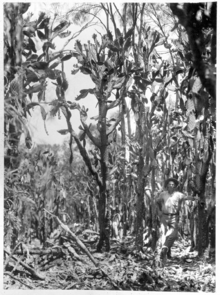Prickly pears in Australia


Prickly pears (Genus Opuntia) are an invasive plant species in Australia.
Prickly pears (mostly Opuntia stricta) were imported into Australia in the 19th century for use as a natural agricultural fence and in an attempt to establish a cochineal dye industry. Many of these, especially the Tiger Pear, quickly became widespread invasive species, rendering 40,000 km2 (15,000 sq mi) of farming land unproductive. The moth Cactoblastis cactorum from South America, whose larvae eat prickly pear, was introduced in 1925 and almost wiped out the population. This case is often cited[1] as an example of successful biological pest control.
There is a monument to the Cactoblastis cactorum in Dalby, Queensland commemorating the eradication of the prickly pear in the region. The Cactoblastis Memorial Hall in Boonarga, Queensland, also commemorating the eradication.[2]
Species
The following Opuntia species are recorded as naturalised in Australia:[3]
- Opuntia aurantiaca
- Opuntia dejecta
- Opuntia dillenii
- Opuntia elata
- Opuntia elatior
- Opuntia engelmannii
- Opuntia ficus-indica
- Opuntia humifusa
- Opuntia leucotricha
- Opuntia microdasys
- Opuntia monacantha
- Opuntia polyacantha
- Opuntia puberula
- Opuntia robusta
- Opuntia schickendantzii
- Opuntia sp. Schrank
- Opuntia streptacantha
- Opuntia stricta
- Opuntia sulphurea
- Opuntia tomentosa
See also
References
- ↑ J. H. Hoffmanna, V. C. Morana and D. A. Zellerb (May 1998). "Evaluation ofCactoblastis cactorum(Lepidoptera: Phycitidae) as a Biological Control Agent of Opuntia stricta (Cactaceae) in the Kruger National Park, South Africa". Biological Control. 12 (1): 20–24. doi:10.1006/bcon.1998.0608.
- ↑ "Cactoblastis Memorial Hall (entry 601273)". Queensland Heritage Register. Queensland Heritage Council. Retrieved 1 August 2014.
- ↑ "Opuntia". Australian Plant Name Index (APNI), IBIS database. Centre for Plant Biodiversity Research, Australian Government, Canberra. Retrieved 18 July 2012.
External links
- Prickly Pear photograph album 1926-1933 digitised and held by State Library of Queensland
- Prickly pears in Australia at the Australian Weeds Committee
- History of prickly pear in Australia - from a New South Wales' perspective